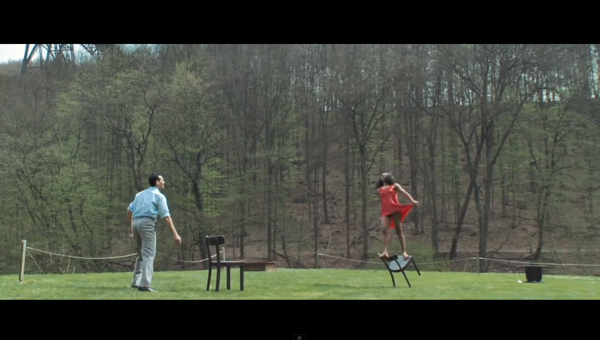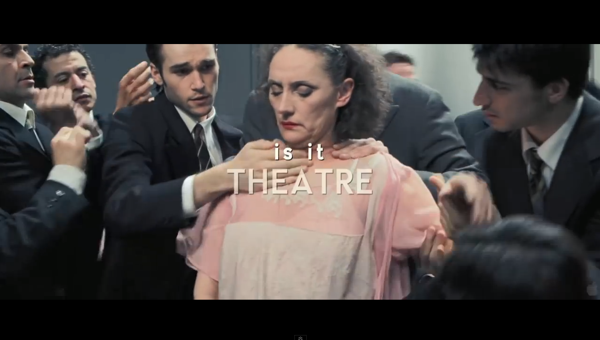In 1978 I followed my then boyfriend to a small town called Essen Werden in Germany. He had been invited to dance in the adjunct dance company of Folkwang Hochschule, a small liberal arts university. At the time, the dance company at Folkwang was under the direction of choreographers Reinhild Hoffman and Susanne Linke. I was very young, had already toured with a couple of companies in LA and New York, and was ready for a break. With nothing but time, I jumped into the school and started taking classes, which were in and of themselves transformative, or watched rehearsals of developing works in a style called Tanz Theater.
One day, early on in my tenure, some friends – fellow dance students at the school – invited us along to go see Pina Bausch, of whom I had never heard. Driving at breakneck autobahn speeds we made it to Wuppertal in just under an hour. Outside the Opera House the performance had already begun. As people gathered, a wan looking Jan Minarek sat on the steps with a fishing pole. Inside I sat transfixed for nearly three uninterrupted hours during which everything I had heretofore conceived of as dance was completely burst open and reinvented: a heavy set ballerina with folds of flesh visible through a long, diaphanous slip, moved like butter; a non-dancing German actor, short and stubby in a white suit strutted in frustration as the two, seemingly “speaking” in completely different “languages,” tried to find common ground in love; behind them both, a legion of men in black suits hoisted the girl on their shoulders, pulled her into the sway of their marching line, or submitted to her physical directions as she waved a white handkerchief chanting “Komm tanz mit mir.” I was stunned.

Although I returned home after just a year, compelled as I was to start my own company, Pina had left her indelible mark on me. The lens through which I viewed dance, and in fact almost any performance whatsoever, had been irrevocably altered. Her work was so completely and utterly other, and at the same time so indescribably familiar. And yet for years, even after her 1984 NY premiere, she was still largely unknown in the US. I tried to tell people about her, about her work, about what I had seen, but great dance is its own visual language that often evades words. I was shocked that so many more dancers, dance aficionados, and artists did not know of her than did. How could this be?
When Pina died unexpectedly in 2009, five days after submitting herself into the hospital due to fatigue, the company and many others around the world who admired her, myself included, were devastated. I received an email that the company was on tour in Eastern Europe when they learned of her passing and that even though they brought the house down, they were too devastated to come out for a bow and the stage stayed empty. To put salt on the wound, the film project that she and German filmmaker Wim Wenders were about to embark upon, and had been planning for years was suddenly halted. It was only after some time to mourn that the dancers went back to Wenders and said they felt they must all go forward without her. Thus, the film Pina was born.

In 2011 I saw the AFI premiere of Pina and met Wim who bowed to me upon learning I knew her and had been a student at the school she later ran. Pina inspired this kind of devotion in people who knew her, not the least of which were her incredible dancers with whom her work had been an engagement in a kind of constant dialogue.
Pina Bausch was remarkable not only as a choreographer, but as a human being. She was at once enormously demanding and enormously empathetic. Her demands and expectations for herself and her dancers as well as her sense of perfectionism were legendary. At the same time, it was in part her humility, empathy, and very humanness and accessibility that made her work as astonishing and utterly moving as it was. Once, when I flew to NY to see a premiere of a new work at BAM that was not touring to LA, I went backstage to see my old classmates – now long time members of her company – and to say hello to Pina, who could always remember my face but never my name. She was so struck by the fact that someone would fly all the way across the country just to see her, she took my face in her hands and kissed my cheek.
It will have been five years this June 30th since her death. Pina Bausch changed the expectations and the ways in which dance and theater were to be experienced for generations. I can only say that I am forever grateful that Wim and the company, in the face of their grief, decided to go forward with the film. It was only after seeing the U2 film and discovering that shooting in 3D would allow him to go “inside” of the dance, that Wim decided he could finally make the film that he and Pina had spent years talking about. And with its nomination for an Academy Award, finally the world came to know about the work of Pina Bausch.
I was fortunate enough to attend the Oscar party for Pina, where Wim came in, fresh from his ‘defeat’, raised his Oscar and proclaimed smiling “It builds character!” We all danced the night away for Pina. “Dance, dance, otherwise we are lost.”
Thank you Wim. Thank you Pina.
